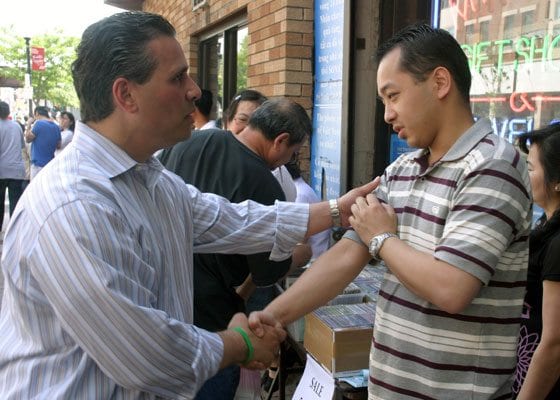

Author: Yawu MillerTomas Gonzalez (left), a former Latino community liaison for Mayor Thomas M. Menino and one of 15 candidates for the four at-large seats on Boston’s City Council, greets Son Nguyen during the Dorchester Day Parade, held Sunday, June 7, 2009. Fourteen of the 15 hopefuls were out Sunday, pressing flesh on Dot Ave.
The 2009 Dorchester Day Parade began with Mayor Thomas M. Menino and Gov. Deval Patrick, followed by the wailing bagpipes of the Boston Police Gaelic Column of Pipes and Drums.
The bulk of the parade was a diverse mix of color guards, floats sponsored by local businesses, a Dixieland jazz band, South Vietnamese military units in crisp khaki uniforms carrying the yellow flag of their former republic, a Caribbean carnival band, antique cars, elected officials and candidates for office.
In all, 14 of the 15 candidates for the four at-large seats on the Boston City Council were present at this year’s parade, held this past Sunday. They handed out literature and waved at passersby, warily eyeing each other’s volunteers as they shook spectators’ hands.
“The folks who are out here are the ones who are serious about connecting with the electorate,” said Egobudike Ezedi, on leave from his job as executive director of the Roxbury YMCA to make his second bid for a seat on the council. “This, for me, is exciting just to be a part of.”
At the beginning of the parade route, Ezedi displayed the tactics of the more energetic candidates, zigzagging from one side of the street to the other to shake as many hands as possible.
The newly-instated requirement that candidates turn in 1,500 signatures narrowed down the field of 23 contenders who pulled nomination papers. But this year’s crop of candidates remains unprecedented in its diversity. Of the 15 council hopefuls who made the ballot, six are white, five are African American, two are Puerto Rican, one is Haitian and one is Vietnamese.
Factoring in a four-way mayoral race, many are expecting a larger than normal turnout for this year’s council elections. With a variety of black, Latino and Asian candidates on the ballot, white candidates who have traditionally benefited from the white ethnic vote may be facing a more level playing field.
And then there’s the speculation about the “Obama factor” — the throngs of newly-registered voters who turned out in 2008 to take part in the historic vote for the nation’s first African American president. No one knows how many of those voters will participate in this year’s municipal election. But no one is taking them for granted.
“In a certain sense, I don’t think I’ll have the benefit of incumbency,” said first-term at-large councilor John Connolly, who estimates turnout in the November election could be as high as 150,000. “I think it’s wide open.”
As it is, the 15 candidates are competing for a finite pool of volunteers, campaign contributions and column inches in the neighborhood papers. When it comes time for the Sept. 22 preliminary, which will winnow the field down to eight, the candidates with the strongest field operations are the ones most likely to prevail.
“You have to be strong all over the city,” said Connolly. “It’s going to be a heck of a race.”
Former labor organizer Felix G. Arroyo agrees that increased competition will lead to increased turnout. And that will make the race more interesting, he said.
“I’m glad 15 people are running,” said Arroyo, whose father, Felix D. Arroyo, served as an at-large councilor from 2003 to 2008. “We’re coming off an election where, in 2007, only 13 percent of the voting population turned out. It’s a good thing for the city when voters will have a choice. Certainly, I hope when the voters look at their options, they give me one of their four votes.”
When the competition is this tight, events like Sunday’s Dorchester Day Parade become even more intensely political.
The three miles of Dorchester Avenue covered by the parade route cut through the heart of white ethnic Dorchester. While Washington Street and Blue Hill Avenue are the major arteries in Dorchester’s black, Caribbean and Cape Verdean community, Dorchester Avenue has a more Irish and Vietnamese flavor.
From the voter-rich precincts in Irish Catholic enclaves of Lower Mills to Ward 7, close to South Boston, Dot Ave straddles the neighborhood’s highest voting, whitest and most conservative precincts.
The route is an urban strip mall of Irish pubs, package stores, Vietnamese nail salons and grocery stores, auto glass shops, auto parts stores, real estate brokers, social service agencies — the commercial lifeline of the city’s most populous neighborhood.
Making his way along the avenue, Tomas Gonzalez, a former Latino community liaison for Menino, spent little time talking, remaining focused on the spectators lining the street. He left barely a hand untouched.
“With 15 people in the race, everybody’s got to get their name out,” he said as his volunteers handed out palm cards.
In the two-or-so miles it took to make it to Adams Street, Ayanna Pressley managed to keep her enthusiasm intact, despite the intensity of the sun and undeniable discomfort of walking in heels.
“This reminds me why I love this city,” she said.
Pressley, who left her job as an aide to Sen. John F. Kerry to run for a council seat, enjoys support from many Democratic Party operatives, as evidenced by her small army of volunteers. She says she doesn’t expect any special advantage from being the only woman in the race.
“The way to win never changes,” she said. “You’ve got to tell your story, share your vision and outwork everyone else.”
Bringing up the rear was Robert Fortes, who said he didn’t assume his position at the end of the parade had anything to do with his being a Republican.
“This is because I’m the best,” said Fortes, an executive with the MBTA. “They always save the best for last.






